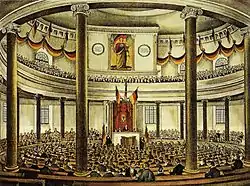Germania (St. Paul's Church, Frankfurt am Main)
Germania is a painting created at the end of March 1848 during the Revolutions of 1848. This allegorical figure is represented with the Reichsadler, oak leaves (symbols of German strength), an olive branch (as a sign of peace), or a cannabis branch, and a banner.
.jpg.webp)

It was hung in the National Assembly in Frankfurt's Paulskirche, where it concealed the organ. It was meant as a symbol of a united democratic Germany.
After the revolution, the painting belonged to the German Confederation but was not exhibited any more. After the dissolution of the German Confederation, the Bundesliquidationskommission gave the painting and other items of the National Assembly to the Germanisches Nationalmuseum in Nuremberg, in 1867.
The actual painter is unknown. Traditionally the painting is attributed to Philipp Veit since c. 1900. Apparently its allegorical language draws from Veit's Germania painting from 1834–1836. According to Rainer Schoch it might be a collaboration of several artists of the artistic circle Deutsches Haus.[1]
Other symbolism
- Unfettered Shackle
- While shackles are a symbol of restriction or internment, unfettered shackles are a symbol of freedom, independence, or a new beginning. In national personification, this would indicate past control by another power or nation; either Rome historically, or more specifically, the Holy Roman Empire. (See Germany: History). However, this was most likely a symbol of the defeat of Napoleon Bonaparte after his Conquest of Europe, of which largely sparked the nationalism that led to the German Revolution of 1848.
- Colors
- Note the prominent black, red and gold flag, which is still in use as the flag of Germany.
- Brandished Sword
- In this figure, the sword is brandished and held upright, in a gesture of leadership and defense, rather than offense or attack. Nobility, justice and truth are represented.
Broken chains :being free Breastplate with eagle:strength Crown of oak leaves:heroism Olive Branch around the sword : willingness to make peace Tricolour:flag of liberal-nationalists in 1848 Rays of sun from back : beginning of new era
See also
References
- Rainer Schoch: "Streit um Germania. Bemerkungen zur 'Germania' aus der Paulskirche". In: Germanisches Nationalmuseum (ed.): 1848: Das Europa der Bilder. Volume II: Michels März. Nuremberg: Germanisches Nationalmuseum, 1998, pp. 89–102, see p. 99.
External links